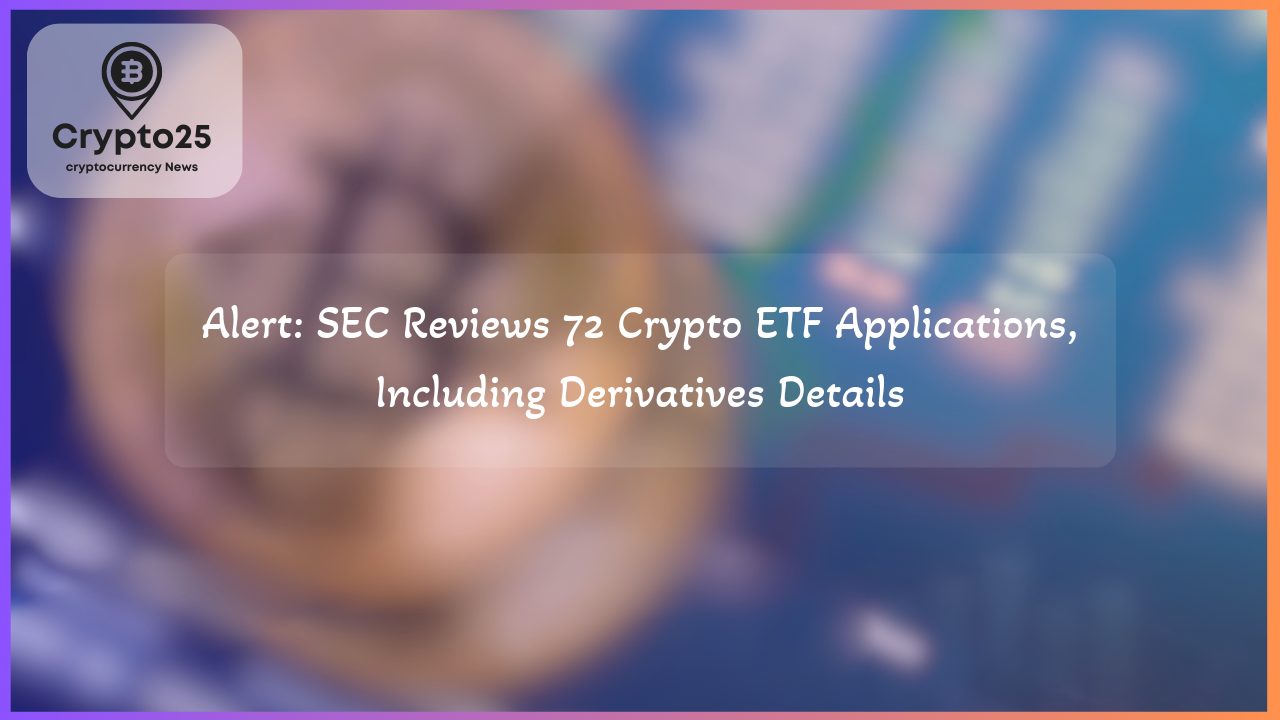
The U.S. Securities and Exchange Commission (SEC) is presently evaluating 72 crypto-related exchange-traded fund (ETF) applications, marking a critical juncture for the cryptocurrency sector. These filings, encompassing a variety of digital assets like XRP, Litecoin (LTC), and Solana (SOL), represent the industry’s latest efforts to bridge traditional finance with emerging blockchain ecosystems. As the SEC deliberates these proposals, the implications for market accessibility and adoption are far-reaching.
## SEC Crypto ETF Approvals: A Broader Market Landscape
The SEC’s review of 72 crypto ETF filings underscores the industry’s robust initiative to introduce a variety of digital assets into mainstream financial markets. According to data shared by Bloomberg analyst Eric Balchunas, these filings represent an unprecedented diversity of offerings, including spot ETFs for popular cryptocurrencies such as Solana, XRP, and Dogecoin. The filings also delve into derivative-based funds for leveraged and inverse trading strategies, catering to risk-tolerant investors seeking advanced exposure to market fluctuations.
Notably, the proposed ETFs also aim to include niche and themed assets, ranging from memecoins like Dogecoin to culture-based groups such as Pudgy Penguins. Beyond traditional products, issuers like ProShares are pushing thematic ETFs to capture specific market tendencies. If these filings gain approval, the widening ETF market could significantly boost the accessibility of digital assets, paralleling the adoption trends seen with streaming services in the music industry.
| Title | Details |
|---|---|
| Market Cap under Crypto ETFs | $1.2 Trillion |
This industry shift could represent a major turning point in decentralized finance (DeFi), enabling both retail and institutional investors to engage with cryptocurrency on more familiar and regulated platforms. However, while opportunities abound, the move also highlights the stiff competition for market share within the ETF sector, particularly among issuers venturing into volatile assets.
## The Opportunity and Risk of Crypto ETFs
The rise of crypto exchange-traded funds opens up significant opportunities for both established cryptocurrencies like Bitcoin (BTC) and emerging options such as Solana and Ethereum (ETH). SEC approval could pave the way for introducing options trading linked to crypto ETFs, granting investors a wider spectrum of tools to navigate volatile price trends. While many view this as an enabling mechanism to accelerate crypto adoption, it is also vital to note the accompanying risks. Leveraged and inverse ETFs, for instance, are tailor-made for speculative traders and come with complex performance structures that could alienate less experienced participants.
Eric Balchunas eloquently compared ETF inclusion to a music band reaching listeners through major streaming platforms. This analogy resonates, as ETF listing does not guarantee immediate mainstream success, but rather establishes a valuable framework for expanding the audience base. With multiple filings still under review, much attention is directed at how the SEC transforms these proposals into actionable trading options for traditional investors.
Moreover, issuers such as Tuttle Capital actively seek to diversify offerings by targeting investors aligned with specific market behaviors, whether through speculative strategies or “thematic” trading hinges. While this development underscores innovation, it also raises fundamental questions regarding regulation: whether such broad-based proposals might dilute institutional interest or create barriers for exchanges.
## Sustained Bitcoin Dominance in Crypto ETFs
Amid this wave of ETF filings, Bitcoin is positioned to remain the dominant force in the crypto-backed investment space, capturing a large share of the anticipated future market. Estimates suggest Bitcoin ETFs currently comprise nearly 90% of total global crypto fund assets. Eric Balchunas projects that, despite new altcoins and themed products entering the market, Bitcoin’s dominance will only marginally decline, settling between 80% and 85%.
Bitcoin’s status as the “institutional gold standard” in cryptocurrency underscores its dominance. It is often the first asset that fund managers pivot toward when designing ETF strategies, owing to its limited supply, high liquidity, and historical significance within crypto markets. With the SEC slated to make significant ETF-related decisions stretching into 2025, the regulatory body’s stance will remain a vital driver in determining the broad adoption trajectory of not only Bitcoin but also other digital assets.
The bigger picture reinforces the belief that crypto ETFs are evolving into a gateway for bridging decentralized and centralized systems. For example, Ethereum-based products—touting added functionalities through contract structures—could challenge Bitcoin by attracting developers and enterprises. Nevertheless, Bitcoin’s entrenched position ensures it will continue to overshadow ETFs structured around altcoins or memecoins.
## Conclusion
The SEC’s ongoing evaluation of crypto ETF filings signifies a pivotal chapter for both financial markets and digital assets. These proposed vehicles promise to bring cryptocurrencies closer to mainstream and institutional audiences, thereby enhancing accessibility and market diversity. Yet, this evolution hinges on balancing opportunities with inherent risks, with Bitcoin expected to maintain its lion’s share in the ETF sector. As mid-2025 deadlines for SEC decisions approach, a transformative future for crypto ETFs is unfolding, one that may define crypto’s role in shaping the future of global finance.
